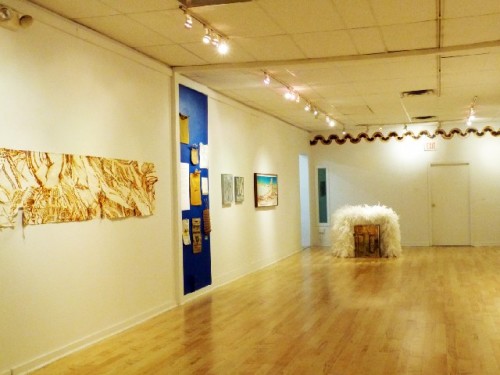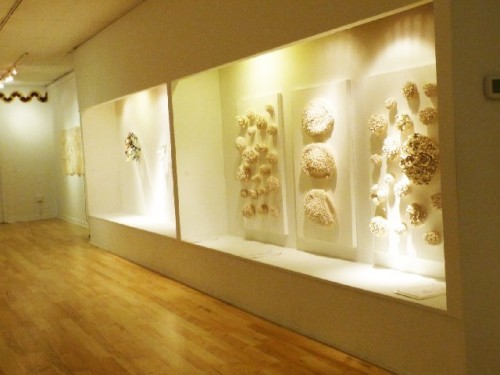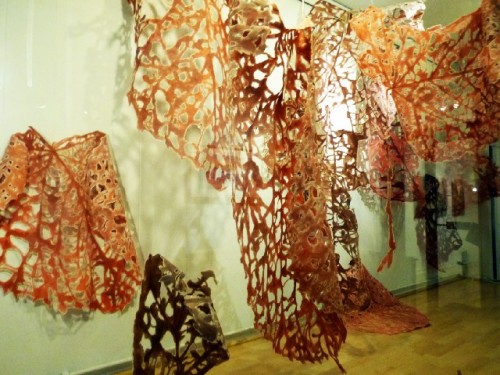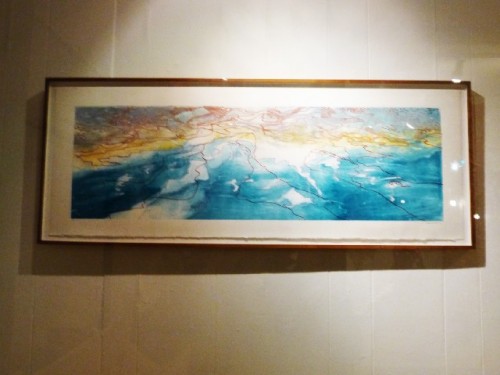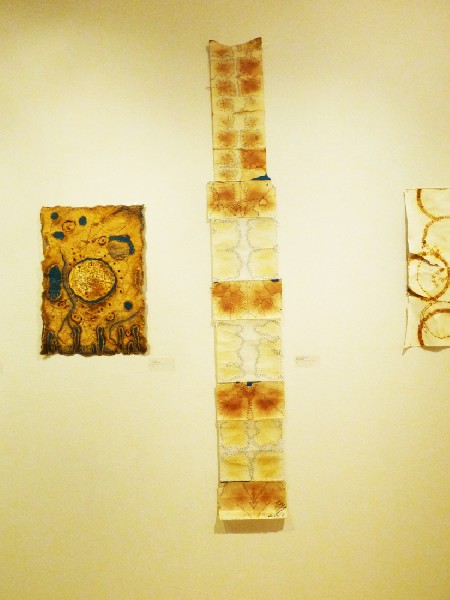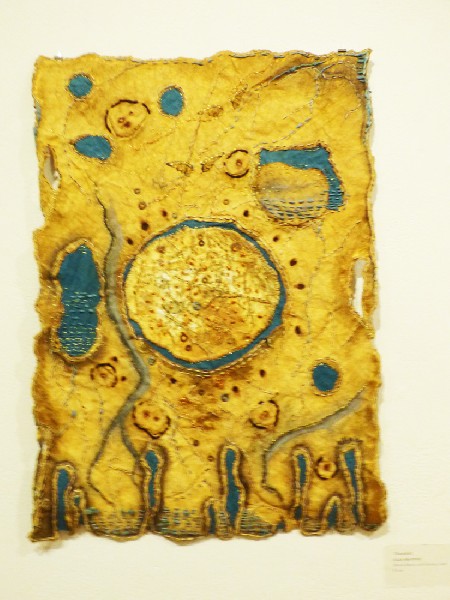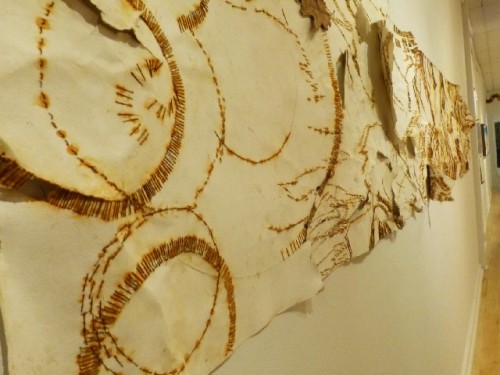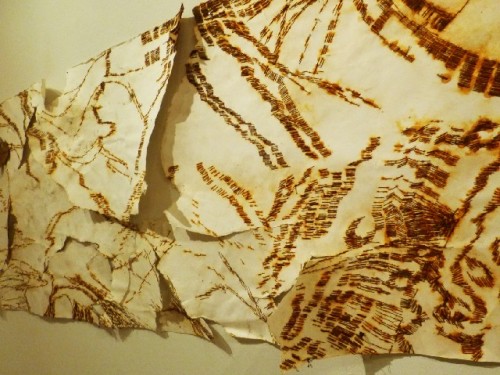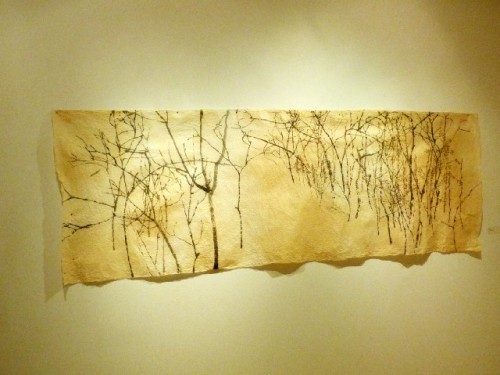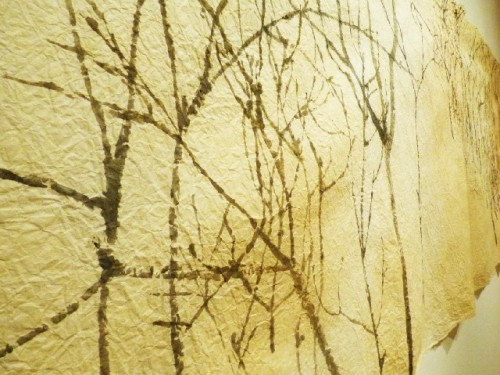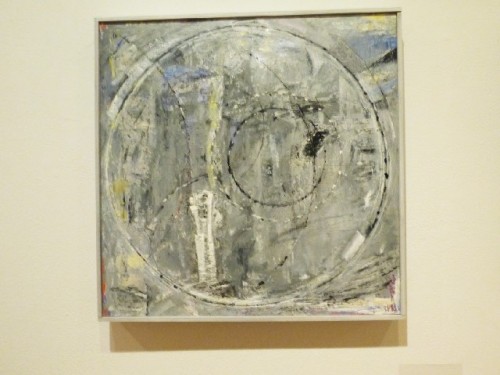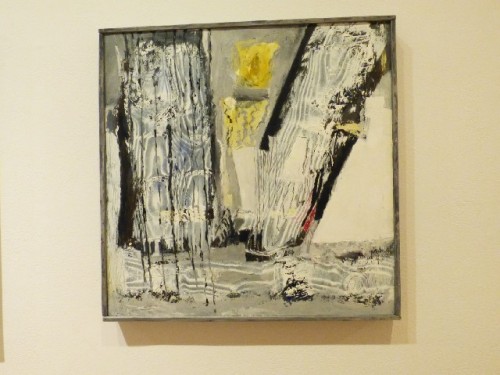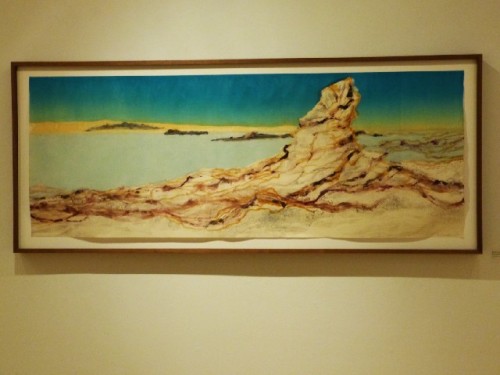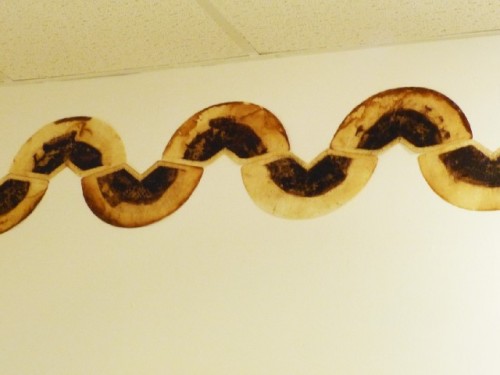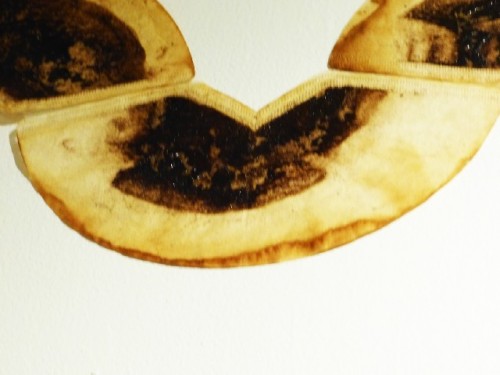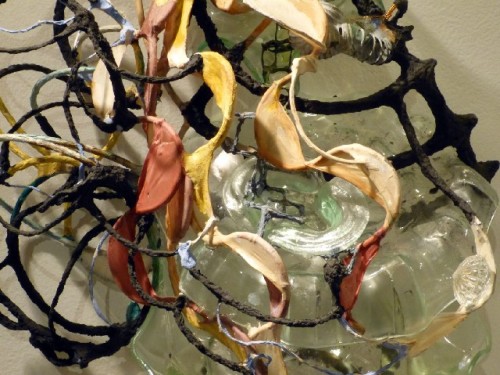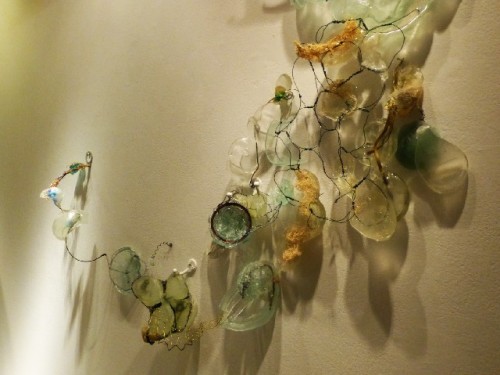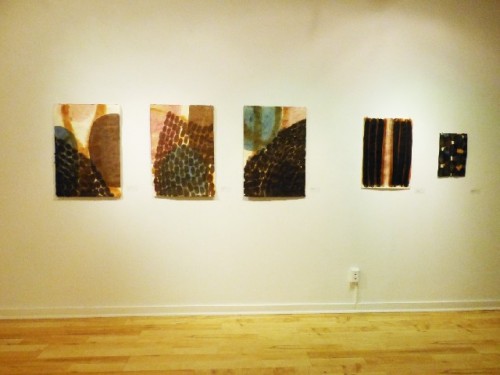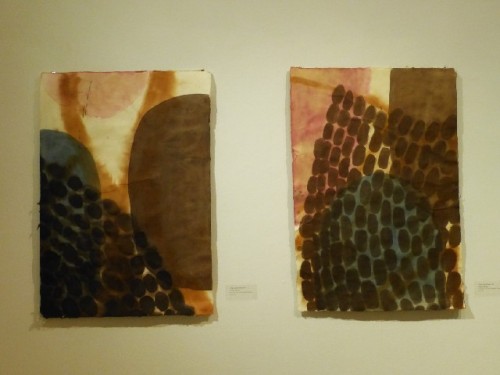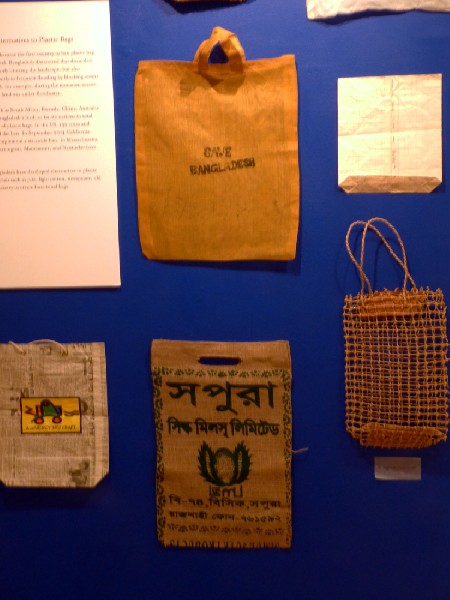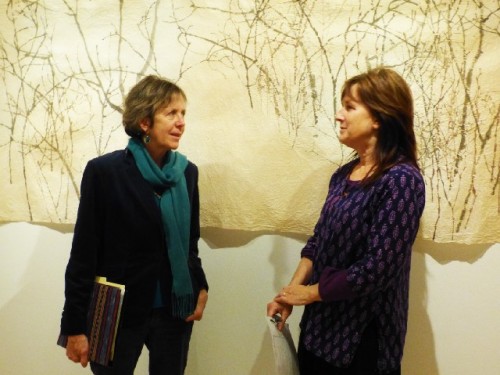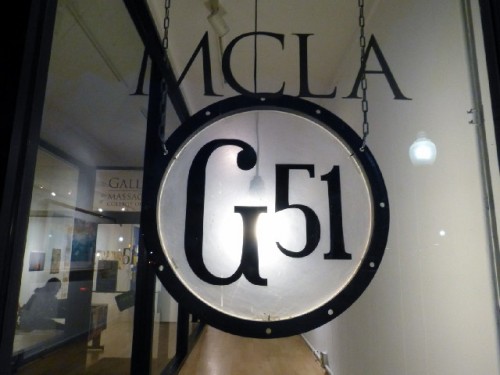Water & Earth : A Call to Protect Fragile Ecosystems
At Gallery 51 in North Adams, MA
By: Astrid Hiemer - Nov 15, 2014
Water & Earth: A Call to Protect Fragile Ecosystems
Exhibition at MCLA/Gallery 51 – 51 Main Street, North Adams, MA –
Until November 30 – open every day from 10 am - 6 pm
Curated by Julia Morgan-Leamon and Sarah Sutro
Participating Artists:
Krisanne Baker ~ Mary-Ellen Beattie ~ Nancy Cohen
Jaeok Lee ~ Tania Love ~ Alka Mathur ~ Susan Newbold
Katherine Porter ~ Linda Stillman ~ Sarah Sutro
Invitation to a free workshop: 'Upcycling - What Can You Do with a Plastic Bag?' - on Saturday, November 22, from 1-3 pm at the gallery.
A guiding paragraph for the exhibition reads as follows:
“Water & Earth exhibits the artwork of regional, national, and international artists who deal with issues of ecology, the environment, and nature. The show explores the possibility of art reaching deeply into the collective values of culture in order to initiate awareness and agency. Can art suggest ways of healthy engagement with the environment, promote respect for nature, and encourage the use of sustainable materials? Each of these invited artists provides a personal glimpse of the fragility and uniqueness of the ground on which we live.”
At first glance the exhibition gives an impression of a cohesive look and calm resonance in mostly white to deep brown tones. Large and small works without frames invite to expand our thoughts beyond the art work’s surface. Materials chosen to produce the works are often recycled, natural and non toxic inks and paints, acid free paper and frames omitted to save wood or simply appropriate for scrolls. And, keep in mind, there is a call for action in our own life and work.
Two window installations introduce the exhibition forcefully and playfully: Tania Love is a Canadian artist, whose work ‘Morphogenesis’ suggests a different form each time, depending on the exhibition space. Here, the hung leaves and natural matter fill a long and deep window. The art work is cut from Kozo Paper and Milk Paint in fall colors, both fragile and strong and point to the cycles of nature.
Susan Nebold’s wide blue oceans and continental masses with extending lines to all parts of Earth remind us of our interconnectedness.
Now inside the gallery Mary-Ellen Beattie shows a whimsical photograph of curling peels from a clementine with stem attached, which is sticking into the air. A delightful view! Her sculpture, aptly titled 'Plastic Bags and Green Door,' reminiscent of an upside down cardboard box that invites to crawl inside, is approximately 4’ tall and equally wide. It is covered by hundreds of ‘white leaves’ made of cut or ripped parts from trash bags inside and out. The short greenish door, which reveals a few layers of paint, provides the opening to the inside. It is also a whimsical sculpture, yet a strong statement for the use of simple materials in unexpected applications.
Alka Mathur, India, contributed two pieces, ‘Shifting Terrains’ and ‘Treasure.’ Women from an NGO in Delhi (Non Governmental Organization) helped her with running stitches in a long vertical work connecting tea stained formerly white paper napkins attached to solid backing. It will fold into a small stack of art. At full scale they reveal images to expand our imagination. She has made a series of them, showing here one example. The smaller work also stitched is colorful and beautiful with an Indian flair. Mathur uses mineral colors and metallic paints and looking at the work it reminds of something much larger, a view from space onto Earth.
Art work is not permanent – nothing in life or on this planet is. The form and condition of two scrolls will suffer each time that they are rolled up, opened or exhibited. These scrolls are not treated like precious age old Japanese or Chinese scroll-paintings. They are loose and horizontally hung. Krisanne Baker’s concept of things falling apart, is witnessed here by ‘Erosion Patterns’ made up of thousands of staples, salt and snow. The resulting rusty colors become a part of an intended torn scroll. She invites the viewer to interact on her website. Beyond entropy Baker is encouraging us to act and care for our ecology.
The second scroll by Tania Love, ‘Field,’ on the opposite wall appears more precious with careful and light field drawings. It has not endured willful damage. Again, she used Kozo paper and milk paint.
Knowing Katherine Porters earlier vibrant, forceful, abstract large and small works, I was surprised by two new paintings in mostly grey and black tones - very strong statements. She wrote: “So many people are fatally detached from the natural and spiritual world – the real world – and the political environmental decisions made based on that disconnection. This will continue to cause untold grief to everyone on earth. For me it is what I try to say in my art.”
The second work by Susan Newbold, ‘Rock of Ages,’ a mono-print, depicts only one mountain close to water and sky. Perhaps, the human race is at peril, our untouched mountains are not - yet.
Look up from the entrance to the opposite gallery wall and Linda Stillman’s ‘Rising Seas/Strandline’ is made up of used coffee filters. A simple and perfect statement! She points to the rising levels of our oceans, the debris in the oceans and man-made materials that wash onto shores around the globe.
Then, Nancy Cohen’s glass installations, comprised of poured and found glass, wires and other material, make visible the tangle of debris on our beaches as well as our current imbalance of life and nature. She has worked with scientists and environmentalists on projects.
Three panels of hand built ceramics in creamy white color by Jaeok Lee were inspired by Echeveria genus, plants that clone themselves in fractal patters in order to reproduce. So, Lee produces her own invented ceramic life forms. Some of the more than 40 individual pieces may also remind us of a stressed coral reef. She called this work ‘Life Interrelated.’ As one may want to identify known forms, the closest ones appear to be flowers or a rose. Artichokes take on a most natural shape.
Sarah Sutro lived for six years in Asia, specifically Thailand and Bangladesh, where she first began using natural colors made of indigo, iron, molasses, acacia and walnut. The titles of her abstract work ‘Time and Tumult,’ ‘Restless Landscape’ and ‘Water Veil’ indicate some of her thoughts while creating them. She uses Mulberry Paper, which is also acid free, and intentionally allows paper and colors to settle while drying.
Her collection of non-plastic shopping bags from overseas are exhibited on a brilliantly blue panel. They are completed by a thoughtful statement. The most significant bag has ‘Save Bangladesh’ stamped on the outside. It was Bangladesh that implemented a ban for plastic bags first in the world. Its land was drowning during monsoons, because millions of plastic bags were clogging the drainage systems.
There is Venice currently attempting to construct dams and lock-systems, which will cost billions of Euros, to keep out floods. St. Marcus Square, precious buildings and palazzos are being flooded hundreds of times yearly. Examples are plenty here in the US as well. All 50 States are currently affected by a very early winter blast of frigid temperatures with snow and ice.
Gallery 51 has an educational component during exhibitions. MCLA classes have come to visit the show to discuss ‘Water & Earth’ and its implications. The exhibition would also be appropriate for High School students from schools in North County. A workshop, scheduled for Saturday, November 22, 1-3 pm, is titled ‘Upcycling – What Can You Do with a Plastic Bag?’ It is free and open to the public. The curators and May Beattie are holding the workshop. Please join in.
Sutro had shared the idea for an environmental and ecology art exhibition with me more than a year ago. Then Morgan-Leamon invited her to co-curate the show at Gallery 51, where it has become a successful exhibition that urges us all to live with care!

